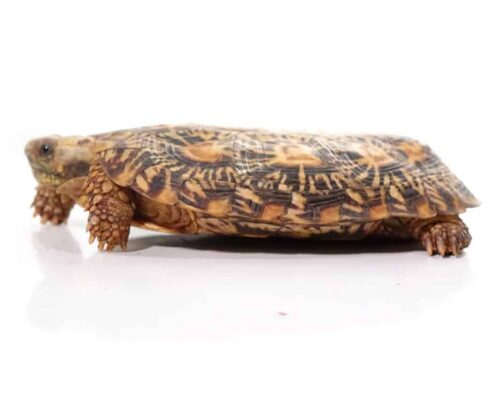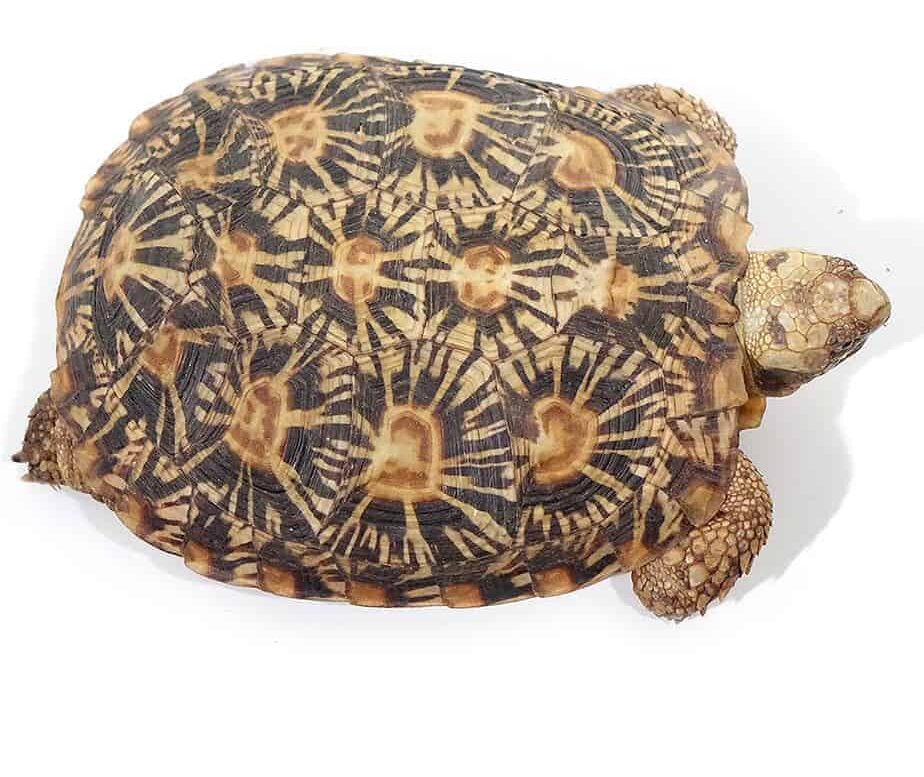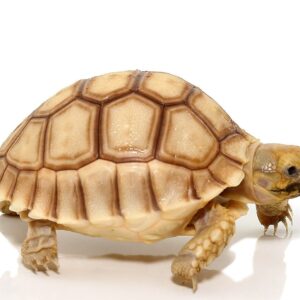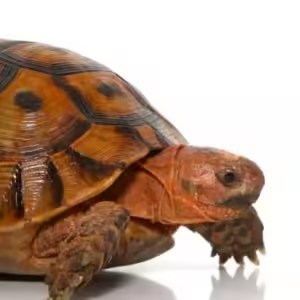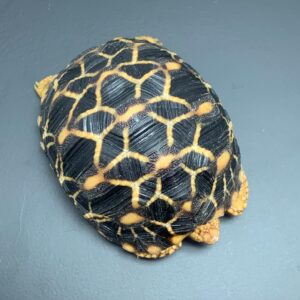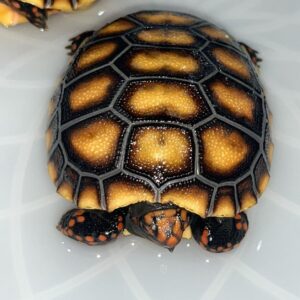Adult Pancake Tortoise For Sale
$799.99
WE HAVE Adult Pancake Tortoise FOR SALE. HERE ARE SOME HIGHLIGHTS:
- Malacochersus tornieri
- Field Collected
- Approximately 7 – 8 Inches In Shell Length
- Adults Are Averaging In Sizes Around 7-8 Inches In Shell Length
- Feeding On Vitamin Dusted Greens, Veggies And Dry Grasses
FUN FACTS!
- Naturally Occurring Out Of Africa Ranging From Kenya And Northern Tanzania
- Interesting African Tortoises With Flexible And Low Flat Shells
- With Proper Care These Tortoises Can Live 40 – 60 Years In Captivity
- These Tortoises Are Used To Hiding Inside Rock Crevices And Outcroppings In The Arid Regions Of Africa
Description
The Pancake Tortoise, scientifically known as Malacochersus tornieri, is a distinctive species of tortoise native to East Africa. Unlike other tortoises, the Pancake Tortoise is remarkable for its unique, flattened, and highly flexible shell. This shell structure allows it to navigate and thrive in its preferred habitats, which include rocky outcrops and savanna environments primarily in Kenya and Tanzania.
The flattened shell of the Pancake Tortoise is not just a visual oddity but serves a critical purpose. The flexibility and low profile enable it to wedge itself into narrow crevices, providing protection from predators and extreme weather conditions. This characteristic is an evolutionary adaptation to its rocky, rugged habitat, where traditional tortoise shells would be less advantageous.
In addition to its unique shell, the Adult Pancake Tortoise is relatively small, with an average length of about 6-7 inches. Their lightweight and agile nature allow them to maneuver quickly compared to other tortoise species. This agility is essential for escaping predators and finding food within their rocky environments.
The natural distribution of the Pancake Tortoise is limited to certain regions of East Africa, making it a species of particular interest and concern for conservationists. The tortoise’s habitat spans across parts of Kenya and Tanzania, where it inhabits areas characterized by rocky terrain and sparse vegetation typical of savanna ecosystems. These regions provide the necessary conditions for their survival, including ample hiding spots and suitable climate.
Understanding the Adult Pancake Tortoise’s habitat and physical characteristics is crucial for their conservation and care. Their unique adaptations not only highlight the diversity of tortoise species but also underscore the importance of preserving their natural environments to ensure their continued survival.
Physical Characteristics and Adaptations
The Adult pancake tortoise (Malacochersus tornieri) possesses a unique set of physical characteristics that distinguish it from other tortoise species. One of the most notable features is its exceptionally flat and lightweight shell. Unlike the dome-shaped shells of many tortoises, the pancake tortoise’s shell is flexible and can compress slightly, which allows it to wedge itself into narrow crevices. This adaptation is crucial for its survival, as it enables the tortoise to escape predators by hiding in rock outcroppings and other tight spaces where larger animals cannot reach.
In addition to its flattened shell, the Adult pancake tortoise is equipped with agile limbs that enhance its ability to maneuver through its rocky habitat. The limbs are strong and capable of gripping uneven surfaces, permitting quick and efficient movement in environments that would be challenging for other tortoises. This agility is complemented by the tortoise’s lightweight build, which further facilitates swift retreats and evasive actions.
The coloration of the pancake tortoise also plays a role in its survival. The shell is typically brown or tan, often with darker markings that help it blend into the rocky landscapes of its native East African habitats. This natural camouflage aids in avoiding detection by predators. The tortoise’s size is relatively modest, with adults typically reaching up to 7 inches in length. Despite their small size, pancake tortoises can have a surprisingly long lifespan, often exceeding 30 years when kept in captivity under optimal conditions.
These physical characteristics and adaptations collectively ensure the pancake tortoise’s ability to thrive in its natural environment. The combination of a flat, flexible shell, agile limbs, and effective camouflage allows this unique reptile to navigate and survive the challenges of its habitat efficiently.
Behavior and Lifestyle
The Pancake Tortoise exhibits unique behavior patterns that distinguish it from other tortoise species. Primarily crepuscular, the Adult Pancake Tortoise is most active during the early hours of dawn and the late hours of dusk. This behavior helps them avoid the extreme temperatures of midday and the potential threats posed by predators.
In terms of social structure, the Pancake Tortoise is often found in small groups or pairs. Unlike many tortoise species that prefer solitary lives, this social inclination allows them to better utilize their environment for safety and thermoregulation. Group living provides the added benefit of increased vigilance against predators, thereby enhancing their survival chances.
One of the most fascinating aspects of the Pancake Tortoise’s behavior is its exceptional climbing ability. Despite their flat and flexible shells, these tortoises are adept climbers. They skillfully navigate rocky terrains, utilizing their sharp claws and lightweight bodies to scale surfaces with remarkable ease. This agility is crucial for accessing preferred hiding spots within rock crevices.
The Adult Pancake Tortoise has a strong preference for hiding in rock cracks, which serves as a primary defense mechanism against predators. These natural shelters not only provide protection but also help regulate their body temperature. By retreating into rock crevices, they can avoid the harsh heat of the sun and maintain a stable, cooler environment. This behavior is particularly essential in their native arid habitats, where temperatures can fluctuate dramatically.
Overall, the Pancake Tortoise’s behavior and lifestyle are intricately adapted to its environment, showcasing a remarkable blend of social interaction, climbing prowess, and strategic hiding. Understanding these behavioral traits is crucial for providing appropriate care and ensuring the well-being of these unique and fascinating creatures.“`html
Diet and Nutrition
The adult pancake tortoise (Malacochersus tornieri) is a herbivorous reptile that thrives on a diet primarily composed of various grasses and leafy greens. In the wild, these tortoises are accustomed to grazing on a variety of fibrous plants, which are crucial for their digestive health and overall well-being. When keeping a adult pancake tortoise in captivity, it is essential to closely mimic their natural diet to ensure they receive the necessary nutrients.
Preferred foods for pancake tortoises include a range of grasses such as timothy hay, Bermuda grass, and orchard grass. Additionally, leafy greens like dandelion greens, collard greens, mustard greens, and turnip greens should be offered regularly. These greens not only provide essential vitamins and minerals but also contribute to the high fiber content required for proper digestion.
While the primary focus should be on grasses and leafy greens, occasional fruits can be included in their diet as a treat. Suitable fruits for pancake tortoises include small amounts of strawberries, apples, and melons. However, fruits should be fed sparingly due to their high sugar content, which can lead to digestive issues if consumed in excess.
To replicate the natural diet of pancake tortoises in captivity, it is crucial to provide a balanced mix of grasses and greens on a daily basis. Fresh vegetables should be thoroughly washed and chopped into manageable pieces to facilitate easy consumption. Additionally, ensuring a varied diet can help prevent selective feeding and nutrient deficiencies.
Calcium and vitamin supplements are vital in preventing shell deformities and other health issues commonly associated with captive tortoises. A powdered calcium supplement can be lightly dusted on their food a few times a week, while a vitamin supplement can be added as recommended by a veterinarian. Proper hydration is also essential, so providing a shallow water dish for soaking and drinking is necessary.
In summary, maintaining a diet that closely resembles their natural habitat, supplemented with essential vitamins and minerals, is key to the health and longevity of the adult pancake tortoise.
Habitat Setup for Captive Care
Creating an ideal habitat for the adult pancake tortoise in captivity is essential to ensure their health and well-being. First and foremost, the enclosure size is a critical factor. For an adult pancake tortoise, a minimum enclosure size of 4 feet by 2 feet is recommended. This space provides enough room for the tortoise to move freely and explore its surroundings, which is crucial for its physical and mental stimulation.
The substrate in the enclosure should closely mimic the natural habitat of the adult pancake tortoise. A mixture of sand and soil works well, as it allows for burrowing and helps maintain the appropriate humidity levels. It is important to keep the substrate dry to prevent respiratory issues, which are common in pancake tortoises when exposed to excessive moisture.
Temperature gradient is another vital aspect of habitat setup. The enclosure should have a basking area with temperatures ranging from 90 to 95 degrees Fahrenheit. The cooler side of the enclosure should maintain temperatures between 75 and 80 degrees Fahrenheit. This gradient allows the tortoise to regulate its body temperature by moving between warmer and cooler areas as needed.
Humidity levels should be kept relatively low, around 30% to 40%, to mimic the arid conditions of their natural habitat. However, occasional misting can help maintain the right balance without making the substrate too damp.
Providing hiding spots and climbing opportunities is crucial for the pancake tortoise’s well-being. These tortoises are naturally shy and appreciate having places to retreat and feel secure. Adding rocks, logs, and other natural decorations can create a more stimulating environment and encourage natural behaviors.
Lastly, UVB lighting is essential for the proper development of the Adult pancake tortoise. UVB rays help in the synthesis of vitamin D3, which is necessary for calcium absorption and healthy shell growth. A UVB bulb should be placed in the enclosure and replaced every six months to ensure its effectiveness.
Health and Common Issues
The adult pancake tortoise, known for its unique flat shell, requires specific attention to maintain optimal health. Understanding the common health problems that can affect these tortoises is crucial for any owner to ensure their well-being.
One prevalent issue among Adult pancake tortoises is respiratory infections. These infections can arise from inadequate humidity levels or a poorly ventilated habitat. Symptoms to watch for include wheezing, nasal discharge, and lethargy. To prevent respiratory infections, it is essential to maintain a balanced humidity level and ensure the enclosure is well-ventilated.
Shell deformities are another concern for Adult pancake tortoises. These deformities often result from improper diet and insufficient exposure to UVB light, which is vital for calcium absorption and shell health. Signs include uneven shell growth or soft spots on the shell. To avoid these issues, provide a balanced diet rich in calcium and ensure your tortoise has access to UVB lighting for about 10-12 hours a day.
Parasites, both internal and external, pose significant health risks. Symptoms of parasitic infections may include weight loss, diarrhea, and a lack of appetite. Regular cleaning of the tortoise’s habitat and routine veterinary check-ups can help prevent infestations. If parasites are detected, a veterinarian can recommend appropriate treatments.
To maintain a healthy adult pancake tortoise, it is vital to adhere to proper hygiene practices within their habitat. This includes regular cleaning of the enclosure, providing fresh water daily, and ensuring that the substrate is free from mold or waste. Regular veterinary check-ups are indispensable for early detection and treatment of health issues, ensuring your tortoise remains healthy and active.
By recognizing the symptoms of common health problems and taking preventive measures, you can significantly enhance the quality of life for your Adult pancake tortoise. Proper care and attention to their unique needs are essential to fostering a healthy and thriving environment for these fascinating creatures.
Breeding and Reproduction
Adult Pancake tortoise exhibit unique breeding habits that are pivotal to their species’ survival. During the courtship phase, males engage in a series of behaviors to attract females, including head bobbing and gentle nudging. These displays are crucial for initiating the mating process. Mating rituals often involve the male following the female closely and occasionally mounting her, a process that can be observed in both wild and captive environments.
Successful breeding of pancake tortoises in captivity requires meticulous attention to environmental conditions. Maintaining an optimal temperature range is crucial, as these tortoises thrive in temperatures between 75°F and 85°F. Seasonal changes play a significant role in stimulating reproductive behaviors; simulating a natural environment with slight temperature drops during the winter months can encourage mating. Adequate hydration and a diet rich in calcium are also essential for reproductive health.
The incubation process of Adult pancake tortoise eggs demands careful monitoring. Once the female lays her eggs, typically in a clutch size ranging from one to three eggs, they need to be transferred to an incubator set at a stable temperature of around 84°F. Humidity levels should be kept between 70% and 80% to mimic the natural nesting conditions. The incubation period generally lasts between 90 to 120 days, depending on environmental factors.
Upon hatching, the care of the young tortoises is paramount. Hatchlings are particularly vulnerable and require a warm, humid environment to thrive. Their enclosures should be kept at a constant temperature of around 85°F, with a humidity level of 70%. A diet consisting of finely chopped greens and calcium supplements will support their rapid growth and development. Regular monitoring and adjustments to their habitat conditions will ensure the hatchlings develop healthily, ultimately contributing to the conservation of this remarkable species.
Conservation Status and Efforts
The adult pancake tortoise (Malacochersus tornieri) is currently classified as Vulnerable by the International Union for Conservation of Nature (IUCN) Red List. This designation underscores the pressing threats facing this unique species in their natural habitat. Among the most significant dangers are habitat destruction and the illegal pet trade. Deforestation and land conversion for agriculture and urban development severely diminish the rocky outcrops and savanna environments that pancake tortoises rely on for shelter and foraging. Additionally, the illegal pet trade exacerbates their population decline, as these tortoises are often captured and sold without regard for conservation laws or the species’ long-term survival.
Conservation efforts are critical to mitigating these threats and ensuring the survival of the Adult pancake tortoise. Various wildlife organizations are actively engaged in protecting the species through a combination of habitat preservation, legal enforcement, and public education. For instance, some initiatives focus on creating protected areas that safeguard crucial habitats from agricultural and urban encroachment. Others work to strengthen legal frameworks that combat the illegal pet trade, ensuring that captured tortoises are returned to the wild or placed in reputable conservation programs.
Individuals can also contribute significantly to the conservation of Adult pancake tortoises. Supporting reputable wildlife organizations through donations or volunteer work can provide essential resources for ongoing conservation projects. Furthermore, responsible pet ownership practices are paramount; potential pet owners should ensure they acquire tortoises from legal, ethical sources that do not contribute to the depletion of wild populations. By fostering a broader understanding of the challenges faced by the Adult pancake tortoise and promoting active participation in conservation efforts, we can help secure a future for this remarkable species.
